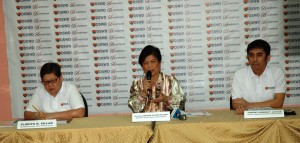
The Department of Social Welfare and Development (DSWD) announced that the 2nd nationwide assessment in the last quarter of the year will be conducted to identify poor families needing assistance of anti-poverty programs and services.
The assessment will be undertaken through the DSWD’s project dubbed as “Listahanan” or the National Household Targeting System for Poverty Reduction (NHTS-PR). Listahanan is an information management system that identifies and assesses who and where the poor are. Listahanan makes available to the national government agencies and social protection stakeholders a pioneer database consisting of comprehensive information about poor families nationwide.
The assessment will cover 15.3 million households estimated from the 2010 Census of Population results for both rural areas and pocket of poverty in urban areas.
It can be recalled that the DSWD conducted the first assessment in 2009 where 10.9 million households were assessed resulting in the identification of 5.25 million as poor using the Proxy Means Test (PMT), a statistical formula that estimates family income based on observable family characteristics.
Beneficiaries of government programs such as Pantawid Pamilya, National Health Insurance Program (NHIP), Social Pension fund, among others, were taken from the 2009 database of Listahanan.
In preparation for the upcoming assessment, DSWD will be hiring 47, 644 field staff comprised of 31,908 enumerators for one month, 6,383 area supervisors for two months, 1,277 area coordinators for three months, 4,038 encoders and 4,038 verifiers for one month. They will undergo rigorous training and will be deployed in different provinces and municipalities and cities all over the country.
Innovations for the 2013 Assessment
DSWD Secretary Dinky Soliman said that for this year’s assessment, the DSWD will use android tablets instead of paper and pencil as the primary data collection tool in urban areas.
“The use of tablets as data collection tool and encoding device will minimize the risk of losing the family assessment forms (FAF) during shipment and expedite the data collection process in urban areas,” Secretary Soliman explained.
However, due to the absence of a reliable internet connection, enumerators assigned in rural areas will continue to use paper and pencil.
Another innovation is the inclusion of the barangay community characteristics derived from the 2009 Census of Population and Housing (CPH) as determinants of poverty status in the new PMT model. Among these are access to mobile phone signal, availability of commercial establishments, and recreational facilities. The new PMT model will also use the non-income variables such as housing features, family assets and access to water and sanitation facilities, among others which were sourced out from 2009 Family Income and Expenditure Survey (FIES) and Labor Force Survey (LFS) as income predictors.
Listahanan will also be able to classify occupation of family members into 431 specific categories consistent with the Philippine Standard Occupation Classification (PSOC).
Budgetary Requirements
The 2nd Nationwide Assessment has a total budget requirement of P1.9 billion which includes the cost of service of field staff, procurement of IT equipment, production of FAFs, and conduct of validation activities, among others.
The result of the 2nd nationwide assessment is expected to become available in 2014, after the data has been finalized with the results of validation and ODA. ###


